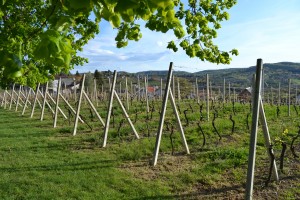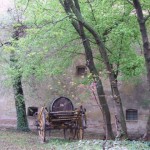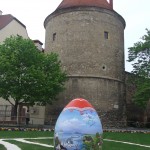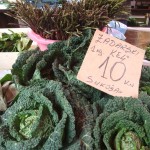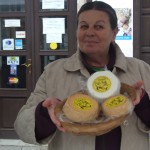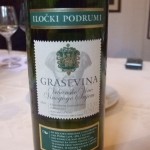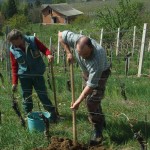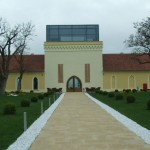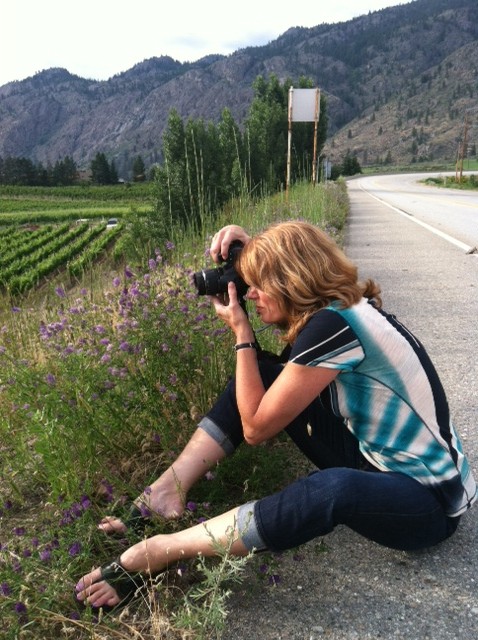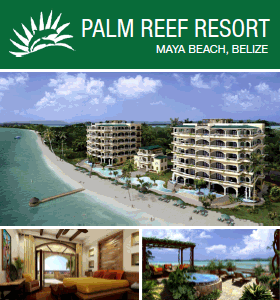Movable Feast East of the Adriatic – eating and drinking in Croatia’s next hot spot
Posted by in Europe | See & Do | UncategorizedArticle appeared in Taste & Travel International Spring 2013 Edition – We nervously keep our distance as the cellar master at Stari Puntijar Restaurant in Zagreb demonstrates how to open a champagne bottle using an antique sabre – a preprandial flourish I’ll likely not pull out at my next dinner party. He removes the foil, leaving the cage intact and holds the base of the bottle with the neck facing away. He locates the stress seam in the glass, the weak spot. In one smooth motion, he slides the blunt edge of the sabre across it, making contact with the lip in a precise, forceful movement that breaks the neck. A second later, he’s pouring the frothing liquid from the ragged bottle. Over rounds of the bubbly and “Zivjeli” (cheers), we applaud his prowess and he tells us next time he’ll use a flaming sabre. Several of the dishes at dinner tonight have been prepared with recipes derived from a 17th century cookbook once belonging to a Croatian Duke, part of the archival collection of Zlatko Puntijar, our host and owner of the oldest restaurant and wine cellar in Zagreb.
Continental Croatia, the interior, doesn’t get much attention or many tourists – yet. The Adriatic’s Dalmatian Coast has been a popular destination for years, but few venture inland. The furthest reaches are only a day trip from Zagreb – the capital – itself only a couple of hours northeast of the coast. Despite the Croatian fondness for the sabre, the country’s shape reminds me more of an inverted hook dagger. The long coast forms the dagger, with Zagreb in the handle and the continent the hook. I’m heading to the easternmost corner, a region circumscribed by the borders of Slovenia and Hungary on the north, Serbia on the east and Bosnia & Herzegovina on the south. The area incorporates culinary influences from its neighbours, as well as traditions inherited from its own nomadic past. The wine-making tradition here is distinct from the rest of Croatia, with four major wine regions and 35 wine-growing hills. With the country scheduled to join the European Union in 2013, I’m sure I’ll be hearing a lot more about continental Croatia.
Spring in Zagreb is alternately rainy, then sunny and always green — I stroll through well-manicured parks of blossoming lilac trees, tulips and daffodils. Zagreb provides a sophisticated, urban perspective on the gastronomic traditions of continental Croatia, as well as the rest of the country and it’s the converging point for the best of all the regional cuisines. I’m in town for the Annual Wine Gourmet Weekend. There’s a huge buzz about sampling these high quality Croatian wines from 150 vineyards. Perfect for a festival, Zagreb is a walkable city of restaurants, cafes, pastry shops, wine & rakia bars (rakia is brandy), art galleries and museums and a growing contemporary scene. The lively outdoor patios of the Upper Town contrast with the serene elegance of the lower, whose green horseshoe is a grid of leafy streets laid out in 1880.
The markets are a great way to learn about food – in central Zagreb, life revolves around the red-roofed dolac, with its huge green market — the cathedral a picturesque backdrop — and an underground market with fish, cheese and meat from the farms and rivers of the interior. I find wild asparagus, freshwater octopus, sauerkraut (cabbage is a Croatian staple), creamy sheep cheese and cured meats made from wild boar, deer and pig. In the afternoon, old men drink tiny glasses of rakia at the old cafes along the market’s edges and watch the crowd bargaining with the headscarved vendors.
Coffee and dessert are an art form here — I have espresso and coffee cake in the stunning 3-storey Art Deco Gradska Kavana City Café. Zagreb was thriving in the 20s and a main stop on the famous Orient Express which travelled from Paris to Istanbul, via Milan and Zagreb. The Hotel Palace’s Art Deco lobby is a tribute to the stars who stayed there, including Sophia Loren and Orson Welles. The stylish Regent Palace was built to accommodate the famous train travellers.
Varazdin, an hour north of Zagreb, was the Baroque capital of Croatia from 1756–76. Close to the Austrian border via Slovenia, it’s called “Little Vienna” — its 500-year-old Town Hall is one of the oldest in Europe and the Old Town Castle a UNESCO heritage site. The local guide undrapes the grand piano in the Baroque Concert Hall and gives an impromptu concert.
The medieval town of Samobor, a half hour from Zagreb, is magical in mist — little arched bridges straddle the river and tidy, red-roofed houses line its edges. It was once a retreat for noblemen and intellectuals escaping city life. The local shops display farm-fresh cheeses and honey. Villagers enjoy morning coffee and cake, savouring the quiet before the Catholic church lets out. Samobor is also known for Bermet, a fortified wine and for a grape mustard which can be sampled at Bermet Filipec Winery.
The fertile farmland of Croatia’s interior is breathtaking — this vast plain is surrounded by limestone mountains and fairybook forests, shaped by the mighty Danube and Drava rivers, whose sinuous curves create marshes to shelter animals, birds and fish (deer, kuna, wild boar, heron, storks, swans, cormorants, carp, pike, catfish). A cormorant dries his wings over a marshy canal and I spot a stork’s nest in a church steeple. This is the real heart of Croatia, the breadbasket of the country.
The vineyards and farms of the interior are a rush of bright yellow; mustard plants are ground cover. Farms nestle in culverts, barely visible but for a wisp of chimney smoke. Created by the black soil of an ancient sea (whose islands formed the vineyard hills), the fields are interrupted only by clumps of dark forest. The misaligned vertical slopes of the well-tended vineyards lend them a playful symmetry.
The indigenous wines of the Slavonia and Danube regions are only beginning to be internationally recognized and include white varietals such as graševina and traminac and reds like frankovka (or blaufrankisch). Graševina is the signature white grape of continental Croatia. Also known as welschriesling in other parts of Europe, it produces its best results here, due to the area’s warmth and humidity. The best examples are full-bodied, with fresh acidity and marked minerality. The Zinfandel grape had its origins in Croatia. It was brought to Italy and then taken to the U.S. in the mid-18th century, with Italian winemakers who settled in California. Visiting Slavonia is George Taber, a U.S. wine writer whose books popularized new world wines — testament to the rising interest in the viticulture of the area. Canadian wine writer, Beppi Crosariol, recently wrote – “The next big wine country? (Hint: It starts with ‘c’ and ends with ‘a’)”.
The smaller wineries preserve Christian traditions dating back to when the monasteries produced the wine. At Bermet Filipec Winery, Antun (Toni) Filipec, whose family has run the business for two hundred years, points to white letters and numbers on his cellar door — “20 + C + M + B + 12” – the numbers of the new year and initials of the three wise men, Caspar (C), Melchior (M) and Balthazar (B) – which were painted on each house at Christmas. At Kutjevo Winery, there is an underground tunnel between the cellar and the monastery; the door was once padlocked to keep the young monks out. Kutjevo was founded in the 13th century; the oldest wine cellar in Croatia. The Ottoman army destroyed the church but not the cellars – they enjoyed the wine, traded it and stayed until 1558 when the monks took over again. Slavonia is one of the largest wine-growing regions in Croatia and the Kutjevo area, where the delightful Krauthaker Winery is located, one of the most important. In spite of its modern methods, the steepest, narrowest rows of Krauthaker’s vineyard are tended by a single ploughhand with a stocky black crop horse. The wine industry was affected by the many wars, from the Ottoman invasion to World War II and revived again after the area emerged from communist influence. The Slavonia region was badly damaged during the War of Independence in the 90s, but several winemakers helped revive the industry.
Bordering on Bosnia-Herzegovina, is the town of Slavonski Brod, where we taste wine with the engaging Dalibor Pejicic at the chic winery, Cikulin. In heavy rain, a traditional village house restaurant, Sobe Tonkic, provides comfort. The meal is cooked in the dining room’s open fireplace, homemade wine and fish paprikash (with handmade paprika) are served by the family and music is provided by young musicians with traditional instruments.
The Baranja Wine Road, an EU-designated wine route, takes us through the rolling Baranja hills to Belje, one of the largest wineries in Croatia, near Osijek, a town at the Serbian border. Touring Belje feels like walking the deck of a giant ocean liner, the shining sea of aluminum tanks beneath us a startling contrast to the wineries we’ve been visiting. Belje has produced some notable, prize-winning wines, as have many of the smaller vineyards and at the stunning Principovac Country Estate, we try more of the area’s wines and cuisine. Osijek was under siege for several months during the 90s, and the scars are still visible here and in nearby towns. The huge, bombed-out water tower in Vukovar is a grim, everyday reminder of the war’s toll – as is the cemetery filled with 90s graves.
In Kopacki Rit Nature Park, close to the Hungarian border, we stop at Kormoran, one of the leading farm village restaurants (or “pustaras”). A shepherd’s stew of deer and wild boar spit-roasted on an open fire, is served with smoked freshwater carp — with paprika sauces from a steaming cauldron and kulen sausage from a 500-pound Slavonian pig.
Everything converges here on the continent and the universe seems in happy alignment. No one expects or wants a tidal wave of tourists, but most everyone anticipates a steady flow of people interested in food, wine and an authentic travel experience. The continent is the diffident star of this earthly paradise called Croatia.
Wineries
Bermet Filipec – www.bermetfilipec.hr.
Cikulin- vinarija.cikulin@yahoo.com
Ilocki Podrum – ivica.pavetic@ilocki-podrumi.hr
Josic Winery – www.josic.hr
Krauthaker www.krauthaker.hr.
Kutjevo – www.kutjevo.com.
Belje – www.belje.hr
Zlatne Gorice – www.zlatni-restorani.com
Coffee & Pastry Shops
Gradska Kavana City Café & Republica Restaurant, Zagreb www.gradskakavana.hr
Amelie, Vlaska 6, Zagreb, Tel: 01/5583360
Slasticarnica U Prolazu Restaurant, Samobor
Trg kralja Tomislava 5, 10430 Tel: 01 3363 704
Palatin Restaurant & Café, Varazdin
Braće Radića 1, 42000 Tel: 01/398300 http://www.palatin-varazdin.com
Restaurants
Zagreb
Stari Puntijar, Gracanska Cesta 65, Medvescak, 10000 tel 01/4675 600, 4675 500
Korcula – www.restoran-korcula.hr
Ciho – Pavla Hatza 15, 10000 Tel 01/4617124
Vinodol – http://www.vinodol-zg.hr/english.html
Republica – http://www.republica.hr/
Pod Grickim Topom – www.restoran-pod-grickim-topom.hr – under the cannon.
Varazdin
Zlatne Gorice – www.zlatni-restorani.com
Verglec – www.verglec.com
Palatin – www.palatin-varazdin.com
Slavonski Brod
SOBE TONKIĆ Village House, Zagrebačka 348
35000 Slavonski Brod, Hrvatska, Tel: (385) 35/273-408
Ilok
Principovac Country Estate, Principovac bb, 32236 Ilok
www.ilocki-podrumi.hr
Salas Goldschmidt, near Vučedol
tel: +385 (0)32 428-234
Accommodation
Zagreb
Hotel Palace (www.palace.hr)
Regent Esplanade (http://www.regenthotels.com/EN/Zagreb/Esplanade-Zagreb)
Hotel Astoria (http://www.hotelastoria.hr/)
Stari Puntijar – new inn to be opening soon – see contact information above
Slavonski Brod
Art Hotel – www.art-hotel.hr
Osijek
Hotel Osijek – www.hotelosijek.hr
Varazdin
Hotel Turist – www.hotel-turist.hr
Karanac
For a farm stay in the Baranja area, contact:
www.belje.hr
For More Information:
Visit the Croatian National Tourist Board at www.us.croatia.hr.
Croatian Wines, visit www.winesofcroatia.com, run by Cliff Rames, sommelier at the Plaza Hotel in New York.
Zagreb Wine Gourmet Weekend, visit http://www.zagrebwinegourmet.com/en
You can follow any responses to this entry through the RSS 2.0 Both comments and pings are currently closed.

